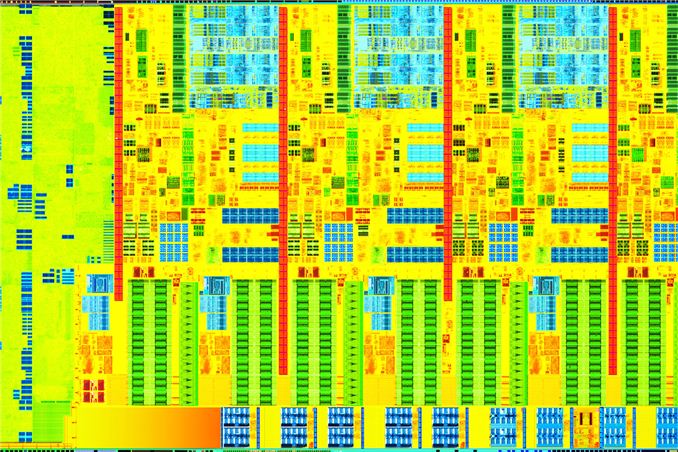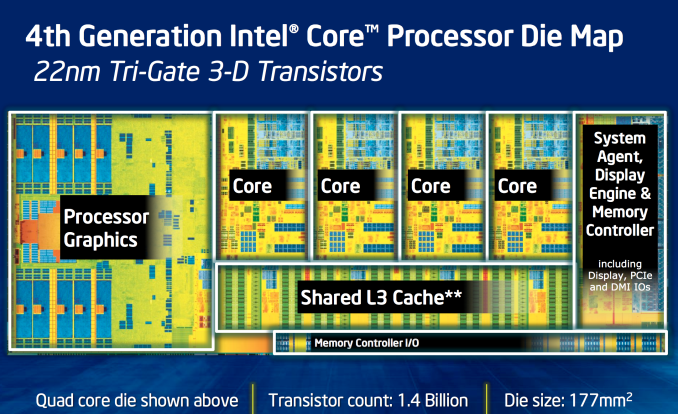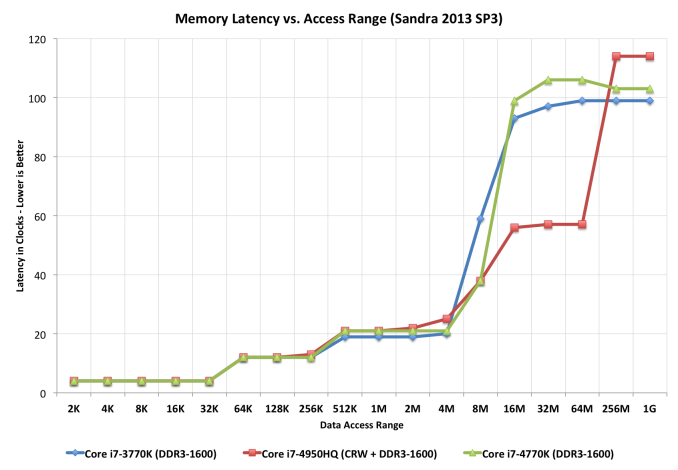The Haswell Review: Intel Core i7-4770K & i5-4670K Tested
by Anand Lal Shimpi on June 1, 2013 10:00 AM EST
This is a very volatile time for Intel. In an ARM-less vacuum, Intel’s Haswell architecture would likely be the most amazing thing to happen to the tech industry in years. In mobile Haswell is slated to bring about the single largest improvement in battery life in Intel history. In graphics, Haswell completely redefines the expectations for processor graphics. There are even some versions that come with an on-package 128MB L4 cache. And on the desktop, Haswell is the epitome of polish and evolution of the Core microprocessor architecture. Everything is better, faster and more efficient.
There’s very little to complain about with Haswell. Sure, the days of insane overclocks without touching voltage knobs are long gone. With any mobile-first, power optimized architecture, any excess frequency at default voltages is viewed as wasted power. So Haswell won’t overclock any better than Ivy Bridge, at least without exotic cooling.
You could also complain that, for a tock, the CPU performance gains aren’t large enough. Intel promised 5 - 15% gains over Ivy Bridge at the same frequencies, and most of my tests agree with that. It’s still forward progress, without substantial increases in power consumption, but it’s not revolutionary. We compare the rest of the industry to Intel’s excellent single threaded performance and generally come away disappointed. The downside to being on the top is that virtually all improvements appear incremental.
The fact of the matter is that the most exciting implementations of Haswell exist outside of the desktop parts. Big gains in battery life, power consumption and even a broadening of the types of form factors the Core family of processors will fit into all apply elsewhere. Over the coming weeks and months we’ll be seeing lots of that, but today, at least in this article, the focus is on the desktop.
Haswell CPU Architecture Recap
Haswell is Intel’s second 22nm microprocessor architecture, a tock in Intel’s nomenclature. I went through a deep dive on Haswell’s Architecture late last year after IDF, but I’ll offer a brief summary here.
At the front end of the pipeline, Haswell improved branch prediction. It’s the execution engine where Intel spent most of its time however. Intel significantly increased the sizes of buffers and datastructures within the CPU core. The out-of-order window grew, to feed an even more parallel set of execution resources.
Intel added two new execution ports (8 vs 6), a first since the introduction of the Core microarchitecture back in 2006.
On the ISA side, Intel added support for AVX2, which includes an FMA operation that considerably increases FP throughput of the machine. With a doubling of peak FP throughput, Intel doubled L1 cache bandwidth to feed the beast. Intel also added support for transactional memory instructions (TSX) on some Haswell SKUs.
The L3 cache is now back on its own power/frequency plane, although most of the time it seems to run in lockstep with the CPU cores. There appears to be a 2 - 3 cycle access penalty as a result of decoupling the L3 cache.


















210 Comments
View All Comments
winterspan - Monday, June 3, 2013 - link
So, can someone catch me up with why Haswell isn't being compared to the older Core i7-39xx Sandy Bridge chips with 6 cores (Sandy Bridge E series)? Is it because they are based on the Xeon architecture and thus are not directly comparable? Will we see an Haswell-E (or Ivy Bridge E) series-based Core i7 with more than 4 cores as a follow-up to the Core i7-39xx?TomWomack - Monday, June 3, 2013 - link
Yes, Ivy Bridge E should appear in the fall; it's not at present quite clear how many cores it will have, possibly only six with the 8- and 12-core units reserved for sale as Xeons.Asking anandtech.com/bench to compare a 4770K and a 3930X, Haswell wins on single-thread and loses on some multi-thread tests, which is what you'd expect.
Kevin G - Monday, June 3, 2013 - link
Probably because it'd be embarrassed in some cases. For lightly threaded workloads, the i7 4770k would come out on top. The six core i7 39xx chips need heavily threaded applications to really shine. Also of note is that GT3e versions of Haswell have 128 MB of L4 cache which further improves IPC. A hypothetical 3.5 Ghz fully functional Haswell with GT3e and recompiled software will likely out run an 8 core socket 2011 Xeon.boe - Monday, June 3, 2013 - link
Pretty much a big steaming pile of meh.They should have at least put more PCIe lanes on the thing otherwise it is just last years processor by another name.
milkod2001 - Monday, June 3, 2013 - link
What revision of i7-4770K was tested here? There's been rumors about early Haswell revisions giving some problems to usb3 connected devices. When in sleep mode it can't wake up after that:http://www.tomshardware.com/news/Haswell-USB-3.0-S...
Would love to see some additional tests covering this problems to make sure I won't spend weeks sending faulty CPU back, waiting and all that s..t.
Diogenes5 - Monday, June 3, 2013 - link
TIL that my 2-year-old i2500k still rocks it for the price and the overclock I have it at (beats any current gen processor for most tasks).Oscarcharliezulu - Monday, June 3, 2013 - link
Thx for the review Anand, as always very thoughtful and well written. You always have a good mix of objective and intelligent subjective. Looking forward to Ivy-E now.psuedonymous - Monday, June 3, 2013 - link
Dangit Anand! Why are you still using 2-pass encoding? Everyone and their dog have switched to the faster and more effective CRF. It may have some obscure use as a synthetic benchmark, but it's certainly not a real world one!skrewler2 - Monday, June 3, 2013 - link
Pretty annoying they're still not including VT-d support in their K series.SanX - Monday, June 3, 2013 - link
Anand gets on my nerves lately. Smells like shill articles everything he personally covers.